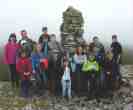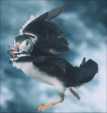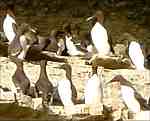| Nature Diary - Caithness
28 July 03
7 August 2002
3 August 2002 At Gills Bay we only had a quick glimpse of one fin possibly bottlenose dolphin again. Last year at Gills there was a large group of harbour porpoise there for several weeks but they are absent at the moment. The bottlenose dolphins are known to attack porpoise and so they may be keeping them away. Sunday was a washout with thick fog and rain, only two of us braved the elements at Strathy Point but we had one good sighting through a gap in the fog of a bottlenose dolphin just swimming by. We got nothing at Lybster. Records of cetaceans are always welcome and you can get a recording form from us if you wish to watch on a regular basis, winter records are very useful indeed. A date for your diaries - Saturday 31st August and Sunday 1st September we will be repeating the cetacean watches so get in touch or just come along if you are interested. Other news the house martins on the centre have fledged their young this week, at least four and they are flying around the dunes learning the essentials of insect catching and ariel acrobatics. We had a ringed plover nesting on the pebbles just near the centre and she has managed to rear two young who are now running along the beach with her learning about life. The nest was in a very busy section of the beach but the eggs are so well camouflaged that they were not detected by beach users. There was one egg left in the nest, which failed for some reason but 2 out of 3 isn't bad I suppose. The cliff nesting birds have finished rearing young (except the fulmers) and most of them have gone back off to the open ocean. I did a guided walk at Duncansby Head yesterday (Thurs) and all the guillemots, razorbills and puffins are gone. Many of the other Caithness breeding birds are now quiet and hiding away moulting feathers and resting after the rigours of chick rearing. It wont be very long before many begin to migrate south and the swans, geese and ducks begin arriving form the north and east. Keep enjoying the sights, sounds and smells of nature around the county and anything of interest you come across then please let us know - 01847 821531.
26 July 2002 Nature Diary From Paul - 12 June 2002 Breeding season now in full swing, eider ducks with young in harbours around the county and a few pairs of shelduck in some harbours also. Ringed plovers are now with chicks dashing around searching for food along the coast. We have seen terns sitting but in lower numbers than last year. The breeding rafts that we constructed at St. Johns Pool have been a success, there are 3 pairs of arctic terns sitting and on the two floating rafts along with a black headed gull pair. The rigid platform had an oystercatcher successfully rear chicks on it and they all appear to be keeping the otters from predating them. The swallows have failed to return to Mary's house in and the numbers seem to be down in the Barrock area. House martins have just completed building nests at the visitor centre and they are a great sight flying around the dunes feeding on those nuisance midges. There are a couple of groups of common scoter in the bay perhaps 50 birds in total at the moment, along with both great northern and red throated divers. The bottlenose dolphins are still around the Dunnet Bay area (over 2 weeks now). I led a walk along Holborn Head on Monday evening and we had great views of about 5 or 6 of them really close in to the headland. Unfortunately had a confirmed report of a dead minke whale at Sarclet recently, we were able to collect the baleen plates and hope to use them in the display eventually. Any cetacean sighting please let the Ranger Service know (01847 821531). Had two recent sighting of painted lady butterflies, these are migrant butterflies from southwest Europe and North Africa and not very common in this area. Early migrants may lay eggs on various plants including thistles and nettles, the caterpillars give rise to a second generation during September and October but these die when the cold weather arrives. Other butterflies on the wing are the green veined white, small tortoiseshell and the red admiral. We have just discovered another colony of small blue butterflies in the Dunnet area, which are also on the wing. Poplar hawk moths and puss moths are also on the wing just at the moment. The poplar hawk moth is large with grey-brown and sculptured wings, it has a reddish patch to the base of the wing, which is hidden, when it is resting, it shows the red if it is disturbed. The puss moth is similar in size to the poplar hawkmoth, grey to white with fine black zigzag marks on the forewings. The name is derived from the cat-like fluffy hair covering the body, both species caterpillars feed on poplar, willow and sallow. Paul
6 May 2002 17 April - Afternoon Update From Paul
17 April 2002 Wheatear have started arriving back in the county particularly along the coastal moors one seen by a local landowner near Duncansby this week. The same landowner had a large group of ravens flying high over Duncansby in the same week. A male snipe was displaying about 2 weeks ago near St. Johns Loch, diving and creating the 'drumming' sound using the widely spread outer tail feathers, sounds like rapidly repeated huhuhuhuhu. Yellowhammer are now singing their 'little bit of bread and no cheeeeese' song in the fields. Expecting anytime now the arrival of the warblers such as willow warbler, sedge warbler and grasshopper warbler (Newtonhill Community Woodland in Wick is a good place to hear grasshopper warbler in summer).
For other bird watching there are public hides at the Loch of Mey and St. Johns Pool.
As well as birds there are other signs of spring; the first sighting of a bumblebee was on 17th March during a walk along the East Coast. There are quite a few small tortoiseshell butterflies around at the moment feeding on the spring flowers such as celandine and coltsfoot. The tadpoles are developing in the pools and the number of small flies is increasing. I was watching two pipistrelle bats feeding over the garden near Halkirk on the evening of the 8th at least they were happy for the fly hatch. We had a report of several porpoise feeding offshore at Strathy Point last week, but they don't seem to have reached the bays over the North Eastern side yet. I saw one porpoise on the 4th March in Dunnet Bay swimming towards Murkle Bay and nothing since. Anyone with cetacean (whales, dolphins, porpoise) sighting please inform the Ranger Service as we are very interested, particularly in winter sightings. Contact the Caithness Ranger Service on 01847 821531 for the North and 01955 607758 for East Caithness. 8 April 2002
7 April 2002
15 March 2002 Birds beginning to pair up and sing regularly, Mary heard the first proper song from chaffinch the other day, skylarks singing for a while now (sounds of summer). Listen out for early morning blackbirds and the lapwings strange call in the fields just now. Spring flowers appearing everywhere, daffodils, winter aconite around my garden and seeing coltsfoot popping up around the county. Coltsfoot sometimes known as 'sons before fathers, because it flowers before the leaves appear. 24 February 2002
22 February 2002 12/02 Red Breasted Mergansers - Keiss beach 16/02 Red Throated Diver - Wick River 16/02 Male Hen Harrrier - Newtonhill Woodland 16/02 Peregrine Falcon - Near Lower Gillock Farm, Wick
9 February 2002
7 February 2002 |


